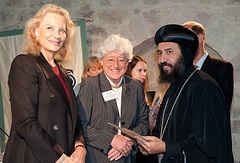|
|
|
|
 |
|
St Pishoy Monastery, Egypt
This page has not been updated since June 2014.
Natroun Valley, Egypt
A founding member of the Green Pilgrimage Network
St Pishoy Monastery is one of nine cities and 22 different organisations and faiths that joined as founding members of the Green Pilgrimage Network, launched at Assisi, Italy, during ARC's Sacred Land Celebration, October 31-Nov 2, 2011. The founder members from St Pishoy Monastery are:
The Coptic Orthodox Church
 |
 |
 |
HRH Princess Michael of Kent; The Hon Mrs Sara Morrison, Vice President Emeritus of WWF International; and His Grace Bishop Angaelos, General Bishop of the Coptic Orthodox Church at a ceremony commemorating the St Pishoy Monastery in the Natroun Valley, Egypt becoming a founder member of the Green Pilgrimage Network. |
The Coptic Orthodox Church is famous for its monasteries: the Christian monastic movement started, in the third century, in the deserts of Egypt.
Today hundreds of thousands of pilgrims come each year to visit the Church’s monasteries in Egypt, and at the ARC Assisi event in November 2011 the Coptic Orthodox Church put forward St Pishoy Monastery in the Natroun Valley as its place of Green Pilgrimage. It wants St Pishoy to be a living and working example for desert communities all over the world.
Green Pilgrimage Actions
St Pishoy Monastery is a model of self-sufficiency and environmental sustainability:
- four hundred acres of desert land have been reclaimed and are now organically farmed
- thousands of trees have been planted
- solar energy provides much of the monastery’s daily energy
- the monastery is self sufficient in its water requirements
And it’s working to become self sufficient to feed its monks, labourers and pilgrims, as well as developing best practice guidelines in how to farm, to share with other desert monasteries.
Useful links
Link here for a pdf of the leaflet issued by the Coptic church to explain to pilgrims visiting St Pishoy why ecology is at the heart of the philosophy of the desert fathers.
St Pishoy Monastery - Coptic Orthodox Green Pilgrimage Theology Statement
Download the full Green Pilgrimage Network handbook here
|
 |
|
|
|
|
|

